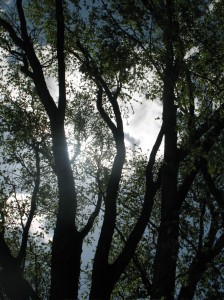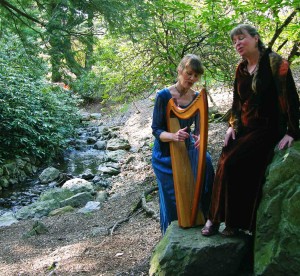IN THE GROVES: Tree Myths, Folktales and Songs from Around the World
Read Diane’s Blog Post about the Recording
In the Groves started out as a performance ~ a walking, singing journey through the verdant groves of Boston’s Arnold Arboretum at the time of the Summer Solstice. The performance was inspired by this rich landscape with its ancient trees and we hope that some of its beauty comes to you in these stories and songs.
Notes on Sources for the CD:
Verdant Groves: a Shaker Hymn This beautiful hymn was harmonized by Marleen Montgomery. Margot worked with Marleen when she first came to Boston. Diane and Margot sing accompanied by Margot on Celtic harp.
The Dancing Spirit of the Birch: a Czechoslovakian Folktale. Songs that weave through the tale are: Poslan Jest Od Boha Andel (16th Century Czech song), Uz Jet Ta Laska (Czech folksong and round) and Jindrichohradecky Zlomek (16th Century Czech song). Adaptation by Diane Edgecomb from several versions of the tale, arrangement of traditional songs by Margot Chamberlain.
The Birch Tree: a Russian folksong. We learned of this wonderful Russian song in an unusual way. At the end of our annual In the Groves performance in the Arnold Arboretum, we tell the story of the Dancing Spirit of the Birch. It is our last story and the birch grove is quite magical as twilight descends. A Russian woman at the event was so moved by the story and the birches at twilight that she slipped off her shoes and walked barefoot through the birch grove singing this song. Her daughter later sent us a copy of the song and it has become one of our favorites.
The translated text of the song is, “In the field stood a birch, Loo~lee, Loo~lee, it stood, Loo~lee, Loo~lee, it stood.” Accordion music added by Tom Megan. The spoken word text in the middle which sees a great birch as the image of the World Tree is part of a Siberian legend adapted from several sources.
Three Green Ladies: a Legend from Cornwall, England. The original source of this story is the book: Forgotten Folktales of the English Counties by Ruth Tongue. It is rare for little to no alterations to be made to a folktale as it comes to life in performance, but the story of the Three Green Ladies as Ruth Tongue documented it at the turn of the 20th century has remained almost word for word in this telling. Musical accompaniment by Margot Chamberlain.
Y Gwcw Fach – The Little Cuckoo: a Welsh Folksong. Sung and played by Margot Chamberlain. In the song a young woman longs to send a message to her loved one far away. She sings, “Little Cuckoo, why are you singing in that prickly gorse? Why don’t you fly off to where there are sweet bushes to sing from. And, while you are there, if you see someone crying tears of salt water, sing a song of hope for him. Sing a song of spring to comfort him.”
Kansakura – Sacred Cherry Tree: a Japanese Legend. The original title of this story is ‘The Holy Cherry Tree of Musubi-no-Kami Temple.’ I found it in the collection: Ancient Tales and Folklore of Japan by Richard Gordon Smith. He says: “The stories in this volume are… from voluminous illustrated diaries… kept by me for some twenty years spent in travel in many lands- the last nine of them almost entirely in Japan, while collecting subjects of natural history for the British Museum.” His volume also contained many other interesting stories including other version of tree legends (a tale is called a legend when it is place-based). The Japanese songs that grace and illuminate the story include: Haru (Spring) a Japanese folksong, Shonai obako (Shonai Lass) a Japanese folksong and Sakura (Cherry Tree) a Japanese koto song. The instrumental version of Sakura was composed by Nancy Gustavson and is used with permission.
Ash Grove: a Traditional Welsh air – Words by John Oxenford.
“The singing of this beautiful song is a cherished childhood memory. I added some bird songs behind it, ending with the thrush songs that sound in the deep woods.” Diane notes. Sung acapella by Diane Edgecomb
The Voice of the Creator: an Australian Aboriginal Myth. Adapted by Diane from several sources including the book Aborigine, Myths and Legend by William Ramsey Smith and from a personal interview with anthropologist Ian McIntosh who, at the time, was acting director of Cultural Survival in Cambridge MA. Background sounds of the creatures are recorded sounds from the Australian outback turned into a sound montage by our engineer Huck Bennert. Multi-tracking of the Digeree doo was done by Tom Megan. The ringing of the harp in the wind is a recording of Margot’s folk harp on a warm but blustery day in February. Blog Post coming soon: Blame it on the Wind! In the Groves took approximately three years to make. Part of the reason was because of the wind!
Tree Planter’s Round: by Dorothy Attneave. This song celebrates weather and the various forms of water that nourish life… “Sing o you falling rain, Dance o snow, Swell you river, river, river, Blow wind blow…” One of our most evocative journeys through the groves centered around a potential rainstorm. We began our performance at the Hunnewell building to go to the different groves of trees with showers threatening and indeed it did start to rain. We were considering turning around, thinking that our audience members would not want to get wet, but they all implored us not to turn back. As we headed to our next destination, we covered Margot’s folk harp with plastic bags and volunteers held an umbrella over the harp as she played. But the greatest joy was walking down the path to the Cherry trees. We were walking in the rain but up ahead the path was bathed in sunlight. Suddenly a double rainbow appeared arching over the open path ahead. At the same moment a heron flew up from the pond, its feathers etched in the evening’s slanting light. What a sight! Later we were rewarded again. As we headed back to the Hunnewell center at the end of the performance it was already dark and, to our right, hundreds of fireflies lit our way home.
Verdant Groves: a Shaker Hymn (originally harmonized by Marleen Montgomery) & Evergreen: A Cherokee Myth. In some ways this gentle song with its flowing melody epitomizes the experiences we have had among the groves of trees. I adapted the Evergreen Myth from several versions including one in Maria Leach’s collection of How and Why Myths entitled How the People Sang the Mountains Up. Every winter when I see the evergreens so green and strong against the snowy landscape, I feel the meaning and the power in this Cherokee myth that tells of the blessing given to the evergreens.
Additional Credits:
Engineer, Editing, Mixing and Sound Effects ~ Huck Bennert
Accordion and Creative Consultant ~ Tom Megan
Photos by Pamela Ruby Russell
Disc Art (Winter Solitaire) by Terry Boutelle
CD Cover and Disc Design ~ Meagan O’Brien
Recorded at Wellspring Sound
Mastered at Soundmirror
Special thanks to: Sarah Failla, Beverly Radda and Kazuko Sakaguchi for help with languages. Also special thanks to Ludmilla Leibman and to our audiences that no matter what the weather want us to venture forth into the beautiful groves of the Arboretum on our annual pilgrimage.




